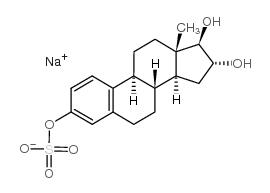Metabolism and biologic response of estrogen sulfates in hormone-dependent and hormone-independent mammary cancer cell lines. Effect of antiestrogens.
J R Pasqualini, C Gelly, B L Nguyen
Index: Ann. N. Y. Acad. Sci. 595 , 106-16, (1990)
Full Text: HTML
Abstract
Different estrogen-3-sulfates (estrone-3-sulfate, estradiol-3-sulfate, and estriol-3-sulfate) can provoke important biologic responses in different mammary cancer cell lines; there is a significant increase in progesterone receptor. However, no significant effect was observed with estrogen-17-sulfates. The reason for the biologic response of estrogen-3-sulfates is that these sulfates are hydrolyzed, and no sulfatase activity for C17-sulfates is present in these cell lines. [3H]-Estrone sulfate is converted in a very high percentage to estradiol (E2) in different hormone-dependent mammary cancer cell lines (MCF-7, R-27, and T47D), but very little or no conversion was found in hormone-independent mammary cancer cell lines (MDA-MB-231 and MDA-MB-436). Different antiestrogens (tamoxifen and its derivatives) and another potent antiestrogen, ICI 164,384, significantly decrease the concentration of estradiol after incubation of estrone sulfate with the different hormone-dependent mammary cancer cell lines. No significant effect in the uptake and conversion of estrone sulfate was observed in hormone-independent mammary cancer cell lines. The data indicate that sulfatase activity for estrone sulfate is very low in the hormone-independent cell lines; however, comparative kinetic studies carried out after homogenization of MCF-7 and MDA-MB-436 cells show that sulfatase activity is similar, suggesting different mechanisms in the hydrolysis of estrone sulfate in hormone-dependent and hormone-independent cell lines. Progesterone also provokes a significant decrease in uptake and in estradiol levels after incubation of [3H]-estrone sulfate with the MCF-7 cell line. It is concluded that estrogen sulfates can play an important role in the biologic response of estrogens in breast cancer and that control of sulfatase and 17-hydroxysteroid dehydrogenase activities are key steps in the concentration and ability of estradiol in the mammary cancer cell line.
Related Compounds
| Structure | Name/CAS No. | Molecular Formula | Articles |
|---|---|---|---|
 |
Estra-1,3,5(10)-triene-3,16,17-triol,3-(hydrogen sulfate), sodium salt (1:1), (16a,17b)-
CAS:5150-64-1 |
C18H23NaO6S |
|
Estriol and its conjugates in late pregnancy determined by e...
1985-10-01 [Clin. Chem. 31(10) , 1698-702, (1985)] |
|
Direct determination of estriol conjugates in amniotic fluid...
2006-01-01 [Rapid Commun. Mass Spectrom. 20(19) , 2995-8, (2006)] |
|
Determination of estrogen 3-sulfates in biological fluids of...
1993-05-01 [Nucl. Med. Biol. 20(4) , 493-501, (1993)] |
|
Bridge-heterologous chemiluminescence enzyme-linked immunoso...
1998-10-01 [Steroids 63(10) , 516-22, (1998)] |
|
Specific imaging of hormone-dependent mammary carcinoma in n...
1995-07-01 [Nucl. Med. Biol. 22(5) , 547-53, (1995)] |